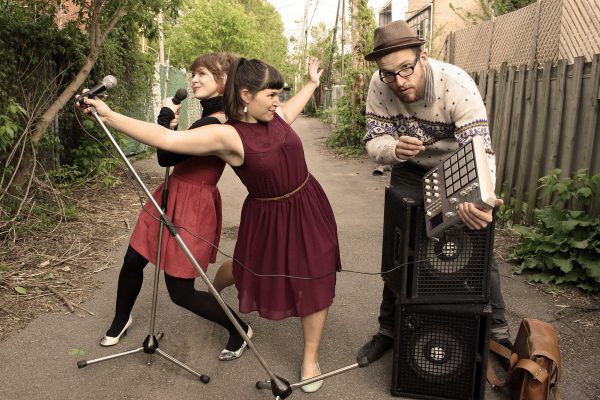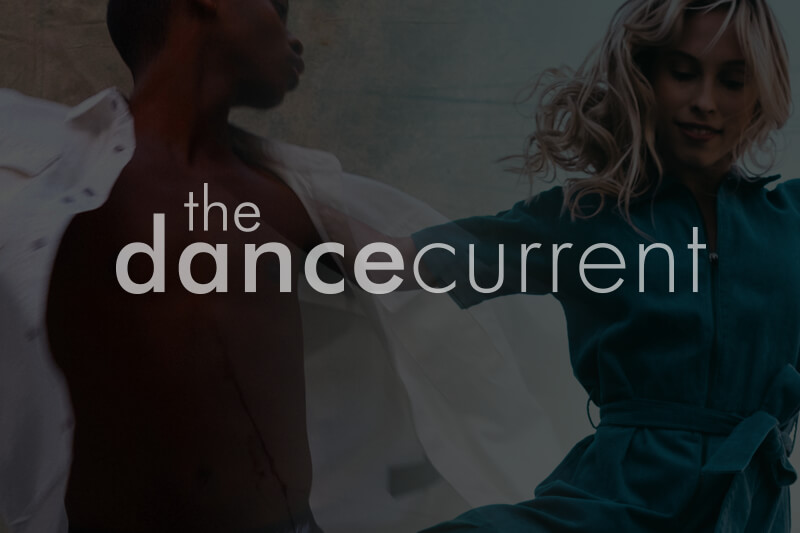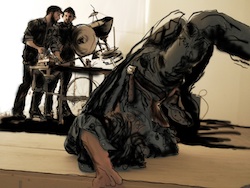For David Pressault’s Danse-Cité production, “Lost Pigeons”, the dancer-choreographer uses the symbol of the sexy pigeon as his central image to probe today’s lost generation of lovers who see relationships slipping away. In his latest couple-themed dance, his quartet of interpreters (Clara Furey, Thea Patterson, David Flewelling and Pressault himself) flags the combative and emotional energies that bear on sexual contacts. The choreographer explores tension, obsession and subjugation, and one can’t help but wonder how much the artist is venturing to speak as himself or as a mere observer of human nature.
Pressault’s stated desire is to jump-start his choreographic process, to allow improvisation to better define his work. Flemish composer-musician Erwin Vann has been collaborating with Pressault over the last couple of years and those sessions, steeped in improvisatory activity, prompted Pressault to realize that he doesn’t need to set all the movement for it to still say something. In his work, he’s allowed himself to be a more mature dance-maker, reasoning that “to say yes, (is) to be a little freer, a little more creative, in terms of what’s developed.” A new willingness to allow material to self-generate, to reinvestigate possibilities, and to not constrict the flow led to this project. Certainly by moving away from playing it safe, he’s experimenting and also embracing higher risk.
At the performance, the audience is seated at cabaret tables that dot the stage floor in the Monument National theatre, with a centre area that is the dancers’ prime dance space. This produces selective viewing and, depending on where you’re sitting, you see some things very close-up, while other activity in other sectors of the space is obstructed. Surrounding the audience and lining the walls are plexiglass and plastic panels, as well as aluminum and copper plumbing piping, which has been fashioned into design works (that will at one point in the choreography be manipulated and worn by the dancers). The only thing missing is beer. Someone near me pipes up that the only thing missing is table dancers. If only the guy knew what was coming up.
Pressault has created a shocker that is crude in parts and contentious. If his intention was to take us to a zone of discomfort, he succeeded. Patterson is the first dancer we see. She undoes a part of the piping and water trickles out. She then walks to one of the panels, pulls off two thin strips of tape and applies each strip to Furey’s eyes. Flewelling does the same to Pressault. What follows are lovely, tender moments in the opening dance sequence: Pressault and Furey gravitate toward each other, cheeks caress, chin meets forehead. It’s a passionate connection between the young Furey, with her long dark hair and eyes (she resembles her mother, actress/singer Carole Laure, who in her early film career excelled at playing the child-woman), and the lanky Pressault, with his salt and pepper hair and long legs and who, as a friend said after watching the show and not knowing he was the choreographer, exudes a “a guy’s guy” energy.
Meanwhile, Flewelling rubs against one of the panels. At the same time, Patterson looks as if she’s applying makeup in a plastic bubble that’s alongside one of the walls, shrouded in the semi-darkness. We hear a woman’s voice (one of the dancers) reciting an uncredited text that includes lines like, “Then I saw hands … the motherfucker bitch.”
Working through reiteration and returning to sequences, Pressault makes us believe that we’re seeing moments from someone’s life. He builds on the long hours spent in the studio with the dancers getting this piece together. The performers have knowledge of each other’s bodies; they connect, react and absorb the shape, the feel, the weight and the emotion of their partners.
Some of the daring in “Lost Pigeons” comes about by virtue of the proximity of the dancers to the audience. When partnering with Furey, Pressault lifts her high, and spins her around, we sense the shift of energy and the vertigo, and we hear the dancers’ breath (and momentarily hold our own). Later, Furey runs and propels herself high and far, and Pressault catches her mid-flight. The action takes place very close to the spectators, and we hear the muffled impact of her body on his. She descends, through his legs. The quick, beautifully timed sequence ends with their hands on each other’s faces.
The lights go up on another entanglement at the other end of the space. In a duet for Patterson and Flewelling, she is like a doll or mannequin who is moved about, touched, and looked at, but who doesn’t do much of anything herself. It’s a bit of a feminist nightmare. Flewelling whose facade is guy-next-door but who embodies an aggressive and cocksure intensity, shifts her arm, cocks her blond head, and positions her on a staircase. He then drags her on the floor around the circumference of the room. He lifts her up, spreads her arms, readjusts her body, and then puts her hands on her ass. Her mouth is agape. He puts her finger in her mouth. Finally he seats her.
You may be reading this and seething. In all fairness though, in Pressault’s couple-themed choreography one observes how power has determined shifting male-female relations. As Pressault freely admits in conversation, “There is such judgment when a man manipulates a woman, but when a woman does that to a man we don’t have the same internal critique.”
In a later scene, Furey walks over to a seated Pressault, and makes him the mannequin. She takes off her jacket, points her finger, and puts a smile on his face, then a frown. She jumps on him, then slides down. She picks him up at one point – they are clearly equals and she is able to bear his weight – and manipulates him. In another section, in a show of pleasure and/or resistance, the woman slaps the guy’s butt, lifts it, then puts his hands on her breast and turns his face.
The dancers show strength and an amazing resilience. If respect and love are far from what’s on the menu here, there are gestures that signal the humanity in the work: the balancing on one foot that enables a spin, which indicates a navigating toward equilibrium and movement beyond; the attempt to stand on another dancer’s extremities alludes to building trust; the leaning over and then backward before a spin suggests risk.
Carina Rose’s architectural designs and sculptural elements are impressive and cohere with the choreography. The pulsing electronic music score by Vann is also well married to the structure and tone of the dance. Lucie Bazzo’s lights are the visual music of colour: they dim and brighten with a sensitivity to the restlessness and rage in the couplings, and the beauty of the veiled dimness that slowly unfurls to connect to some sort of consciousness, whether it’s fear, erotic longing or bitterness.
As far as this reviewer is concerned, Pressault’s complete misstep occurs in the final tableau when he falls prey to the gratuitous. He strips Furey and Flewelling as they move forward toward one another, eyes taped shut, and leads us to really speculate on his intentions.
Tagged: Contemporary, Performance, Montréal , QC





